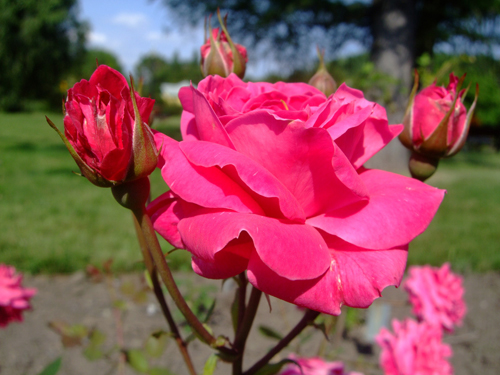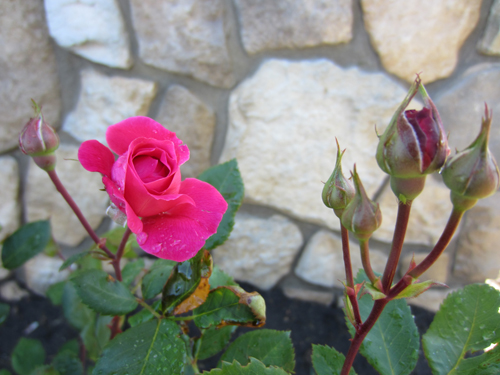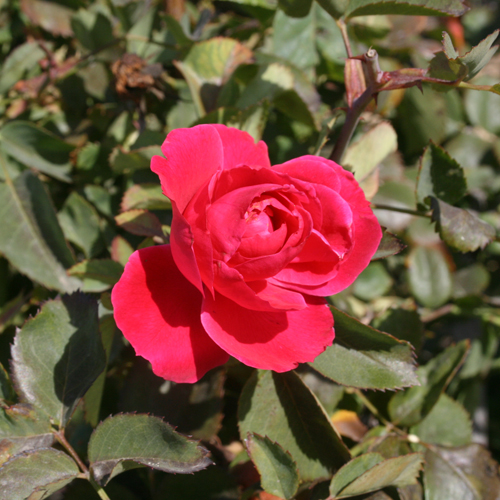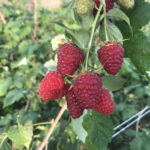Rose Alexander MacKenzie
It is not for nothing that the rose is called the “queen of gardens”! A rare landscape group does without this blooming beauty, a rare amateur gardener or summer resident will not plant at least one rose bush on his site. Therefore, a great variety of them have been bred. Now let's talk about another of them - the rose Alexander Mackenzie.

History of creation
This variety was bred and introduced on the instructions of the Department of Agriculture of Canada, at the Central Experimental Farm in the province of Ontario, in 1985. The variety is named in honor of an outstanding person, natural scientist, Scottish by nationality, who, as it is believed, in the second quarter of the 18th century, was the first to cross all of North America from the Atlantic to the Pacific Ocean. Before that, he still managed to visit the entire Pacific coast of British Columbia, studying the flora of these places.
Such well-known roses as Queen Elizabeth, Red Dawn and Suzanne took part in the creation of the variety.
Description of appearance and characteristic features
The result is an excellent variety, known and in demand in many regions of the world. Mackenzie belongs to the typical Canadian park repairing roses, namely to the part that is classified as Explorer roses. All their numerous advantages and small disadvantages are inherent in it.

Crown shape
The bush of this flower is powerful, high (the average height is about 2 meters, but in some cases the shoots reach almost three). Thus, we can say that this is a typical "scrub" - a rose that can be called half-leafed. The width of the bush is also rather big, about one and a half meters. Shoots are erect, thick, and only at the very end do they gracefully droop; can decorate a high wall of the house without additional support.
The foliage is dark green, large and shiny, with a waxy surface.
Flowering features
The flowers are bright red, not very large (from 5 to 8 cm in diameter), but they are collected in large brushes of 5-15 pieces. Each flower is terry, consisting of 20 - 40 petals. At first, young petals are lighter, but over time they darken, the redness turns into deep, blackish tones. Even the buds of this variety amaze with their chiseled shape, reminiscent of a red tulip. The blooming rose emits a light but persistent scent, with clear notes of ripe strawberries (some people smell raspberries).

Remontant flowering, repeated twice a season. Between the waves of flowering, single flowers are also formed on the bush. Minor disadvantages include the fact that after the last rains, the outer petals often turn brown and dry.
Features of agricultural technology
Like all roses of her “native” group, Alexander Mackenzie is distinguished by unpretentiousness and increased resistance to disease.
Interesting! In 1998, in Montreal, a kind of "competition" among roses was held in terms of resistance to the main diseases of the species. Our heroine showed excellent results, entering the top three, showing an infection rate of no more than 5%.
The frost resistance of this variety, according to the US Department of Agriculture (USDA), corresponds to the 4th zone. The rose can withstand up to -25 ° without cover, and up to -40 ° with light cover.
The plant is quite demanding on the quality of the soil, and this can be called its relative disadvantage. They should be rich in humus, constantly loosen well and be saturated with air. The place of growth should be well drained, it needs at least several hours a day to be illuminated by direct sunlight.
How is it used in horticulture
This is a versatile plant! It can be grown as a specimen that attracts the eyes of others, but it can also be introduced into a wide variety of landscape groups and plantings. As already mentioned, a rose can sometimes "pretend to be climbing", decorating an arch, a high facade wall or a canopy. Her bush will show off flowers for a long time, delighting the owner. With all these advantages, even a novice gardener who does not have deep knowledge and experience can handle it.









This rose (like all "Canadians") is a real treasure! The variety is not capricious - it does not require anything, except for not frequent, but abundant watering. The rose in the garden looks gorgeous - the bush is tall with thick erect stems (it is inconvenient only for the first 2-3 years, as it falls apart, but then it firmly stands on its own feet), the flowers are huge with a lot of petals, they winters perfectly with practically no shelter - the only thing is that in the first winter you need to build a high hillock, and in the spring a caring rose grower will have a surprise - under the hillock he will find awakened buds with roots at the base - this rose multiplies once. But there is also a drawback - it often suffers from black spot, you need to monitor ventilation and carry out processing on time.